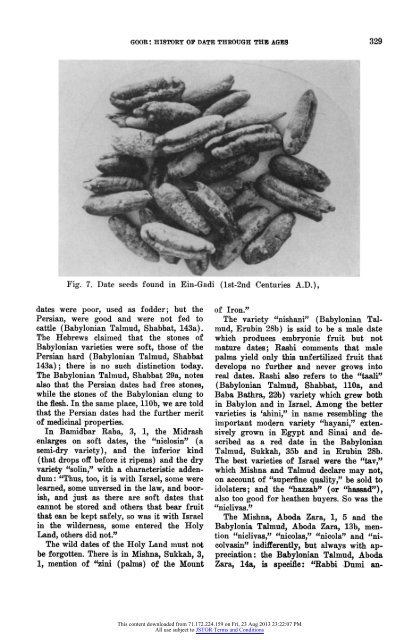The History of the Date through the Ages in the Holy Land
The History of the Date through the Ages in the Holy Land
The History of the Date through the Ages in the Holy Land
You also want an ePaper? Increase the reach of your titles
YUMPU automatically turns print PDFs into web optimized ePapers that Google loves.
GOOR: HISTORY OF DATE HOG TBAE 329<br />
*<br />
.:<br />
....~~~~~~~~~~~~~~~~~~~~~~~~~~~~~~~~~~~~~~~.<br />
..... .::::<br />
........ ...<br />
....<br />
.. .......<br />
E _ g u , . ...::::....~~~~~~~~<br />
..<br />
i ....<br />
Fi. 7. <strong>Date</strong> seeds found <strong>in</strong> E<strong>in</strong>-Gadi (lst-2nd Centuries A.D.),~~~~~~~~~~~~~~~~~~~<br />
. ...<br />
dates were poor, used as fodder; but <strong>the</strong><br />
Persian, were good and were not fed to<br />
cattle (Babylonian Talmud, Shabbat, 143a).<br />
<strong>The</strong> Hebrews claimed that <strong>the</strong> stones <strong>of</strong><br />
Babylonian varieties were s<strong>of</strong>t, those <strong>of</strong> <strong>the</strong><br />
Persian hard (Babylonian Talmud, Shabbat<br />
143a); <strong>the</strong>re is no such dist<strong>in</strong>ction today.<br />
<strong>The</strong> Babylonian Talmud, Shabbat 29a, notes<br />
also that <strong>the</strong> Persian dates had free stones,<br />
while <strong>the</strong> stones <strong>of</strong> <strong>the</strong> Babylonian clung to<br />
<strong>the</strong> flesh. In <strong>the</strong> same place, ilOb, we are told<br />
that <strong>the</strong> Persian dates had <strong>the</strong> fur<strong>the</strong>r merit<br />
<strong>of</strong> medic<strong>in</strong>al properties.<br />
In Bamidbar Raba, 3, 1, <strong>the</strong> Midrash<br />
enlarges on s<strong>of</strong>t dates, <strong>the</strong> "niclos<strong>in</strong>" (a<br />
semi-dry variety), and <strong>the</strong> <strong>in</strong>ferior k<strong>in</strong>d<br />
(that drops <strong>of</strong>f before it ripens) and <strong>the</strong> dry<br />
variety "sol<strong>in</strong>," with a characteristic addendum:<br />
"Thus, too, it is with Israel, some were<br />
learned, some unversed <strong>in</strong> <strong>the</strong> law, and boorish,<br />
and just as <strong>the</strong>re are s<strong>of</strong>t dates that<br />
cannot be stored and o<strong>the</strong>rs that bear fruit<br />
that can be kept safely, so was it with Israel<br />
<strong>in</strong> <strong>the</strong> wilderness, some entered <strong>the</strong> <strong>Holy</strong><br />
<strong>Land</strong>, o<strong>the</strong>rs did not."<br />
<strong>The</strong> wild dates <strong>of</strong> <strong>the</strong> <strong>Holy</strong> <strong>Land</strong> must not<br />
be forgotten. <strong>The</strong>re is <strong>in</strong> Mishna, Sukkah, 3,<br />
1, mention <strong>of</strong> "z<strong>in</strong>i (palms) <strong>of</strong> <strong>the</strong> Mount<br />
<strong>of</strong> Iron."<br />
<strong>The</strong> variety "nishani" (Babylonian Talmud,<br />
Erub<strong>in</strong> 28b) is said to be a male date<br />
which produces embryonic fruit but not<br />
mature dates; Rashi comments that male<br />
palms yield only this unfertilized fruit that<br />
develops no fur<strong>the</strong>r and never grows <strong>in</strong>to<br />
real dates. Rashi also refers to <strong>the</strong> "taali"<br />
(Babylonian Talmud, Shabbat, llOa, and<br />
Baba Bathra, 2gb) variety which grew both<br />
<strong>in</strong> Babylon and <strong>in</strong> Israel. Among <strong>the</strong> better<br />
varieties is 'ah<strong>in</strong>i," <strong>in</strong> name resembl<strong>in</strong>g <strong>the</strong><br />
important modern variety "hayani," extensively<br />
grown <strong>in</strong> Egypt and S<strong>in</strong>ai and described<br />
as a red date <strong>in</strong> <strong>the</strong> Babylonian<br />
Talmud, Sukkah, 35b and <strong>in</strong> Erub<strong>in</strong> 28b.<br />
<strong>The</strong> best varieties <strong>of</strong> Israel were <strong>the</strong> "tav,"<br />
which Mishna and Talmud declare may not,<br />
on account <strong>of</strong> "superf<strong>in</strong>e quality," be sold to<br />
idolaters; and <strong>the</strong> "hazzab" (or "1hassad"),<br />
also too good for hea<strong>the</strong>n buyers. So was <strong>the</strong><br />
"niclivas."<br />
<strong>The</strong> Mishna, Aboda Zara, 1, 5 and <strong>the</strong><br />
Babylonia Talmud, Aboda Zara, 13b, mention<br />
"niclivas," "nicolas," "nicola" and "nicolvas<strong>in</strong>"<br />
<strong>in</strong>differently, but always with appreciation:<br />
<strong>the</strong> Babylonian Talmud, Aboda<br />
Zara, 14a, is specific: "Rabbi -Dumi an-<br />
This content downloaded from 71.172.224.159 on Fri, 23 Aug 2013 23:22:07 PM<br />
All use subject to JSTOR Terms and Conditions
















